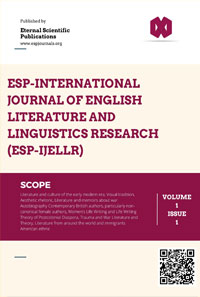ESP International Journal of English Literature and Linguistics Research (ESP-IJELLR)
Citation :
Devadharshini G, Kishalini C, 2025. "Language Shift and Death Among Indigenous Dialects in India: Causes and Consequences" ESP-International Journal of English Literature and Linguistics Research (ESP- IJELLR) Volume 3, Issue 1: 19-27.
Abstract :
Bilingual India with more than 1,600 languages and numerous native tongues spoken across its vast geographical and cultural landscape is one of most linguistically diverse countries in the world. These languages have unique cultural ceremonial roles, oral traditions, social structures and ecological knowledge developed over generations well beyond the role of communicative devices. However, many of India's mother tongues are quickly disappearing, and some have reached the stage of extinction. This phenomenon, often dubbed as language shift and death, has severe effects on the cultural, social and natural environment of the indigenous communities.Language shift is the process through which speakers shift functional operations of a minority language to another. This trend is often a result of perceived socio-economic gains, educational policy, urbanization and the impact of globalization. This situation is exacerbated by factors such as disruption of intergenerational language acquisition, ecological dislocation and lack of state support (Andric) Systematic promotion This phenomenon has even been felt at the expense of competing indigenous languages. Unconscious promotion of linguistic diversity comes from political and educational systems that favor dominant languages at the expense of regional ones. Also, the omnipresence of technology and mass media in the dominant languages lessens the social and practical worth of indigenous dialects– especially among youth. Language death has serious repercussions. At a cultural level, when we lose a language, so too do we lose community identity, oral histories and collective memory. On the social level, language loss weakens the bond among people and disrupts communication between generations. On an ecological level, the indigenous languages contain invaluable knowledge regarding the biodiversity of their region, tradition cultivation practices and natural resource management strategies which if lost are unlikely to be recorded elsewhere. Case studies like Aka-Kora’s extinction in Andaman Islands and Bihar’s broken Bihari (e.g., Angika, Bajjika) illustrate socio-economic, political, environmental factors working together to accelerate one language death.The urgent requirement of tools and methods to document, conserve and revive endangered languages in India is highlighted. Some strategies are focused on comprehensive linguistic documentation; additional purposes of these strategies are including the indigenous languages into the school curriculum, and community-based projects that help their speakers preserve and recover their language. India can safeguard its linguistic diversity and these unique cultural and ecological treasures for posterity with the adoption of a layered inclusive approach. The paper highlights that maintaining cultural identity, social cohesion and environmental knowledge are dependent on the survival of indigenous languages, which is not merely a language issue.
References :
[1] Parshad, R. D. (2016). "What is India speaking? Exploring the 'Hinglish' invasion." ScienceDirect. Retrieved from https://www.sciencedirect.com/science/article/abs/pii/S0378437116000236
[2] Krishna, D. (2025). "Climate change threatens Bihar's indigenous languages." The Times of India. Retrieved from https://timesofindia.indiatimes.com/city/patna/climate-change-threatens-bihars-indigenous-languages/articleshow/121438706.cms
[3] Goswami, R. (2025). "Analyzing the Rise of Green Linguistics (Ecolinguistics) in Indian Languages." Language in India. Retrieved from https://languageinindia.com/may2025/goswamiecolinguistics.pdf
[4] "Documenting India's Endangered Languages." Press Information Bureau. Retrieved from https://www.pib.gov.in/FeaturesDeatils.aspx?ModuleId=2&NoteId=155013&id=155013
[5] "Centering Indigenous Languages in India's Schools." YES! Magazine. Retrieved from https://www.yesmagazine.org/social-justice/2023/10/23/india-schools-indigenous-languages-education
[6] "Endangered Languages in India Making a Comeback." TransPerfect. Retrieved from https://www.transperfect.com/blog/lost-revived-endangered-languages-india-making-comeback
[7] "Language Shift and Identity Reproduction among Diaspora Sindhis in India and Southeast Asia." Cambridge University Press. Retrieved from https://www.cambridge.org/core/journals/modern-asian-studies/article/language-shift-and-identity-reproduction-among-diaspora-sindhis-in-india-and-southeast-asia/678711394095029BE7AC10943ADA6946
[8] "Language Shift among the Tribal Languages of India: A Case Study in Bihar." Academia.edu. Retrieved from https://www.academia.edu/849824/_Language_Shift_among_the_Tribal_Languages_of_India_A_Case_Study_in_Bihar
[9] "Documentation and Description of Nihali, a Critically Endangered Language Isolate of India." Culture in Crisis. Retrieved from https://cultureincrisis.org/projects/documentation-and-description-of-nihali-a-critically-endangered-language-isolate-of-india
[10] "Language, Artificial Education, and Future-Making in Indigenous Communities." Taylor & Francis Online. Retrieved from https://www.tandfonline.com/doi/full/10.1080/17439884.2023.2278111
[11] "Language Revitalization and Community Initiatives: An Indian Perspective." ResearchGate. Retrieved from https://www.researchgate.net/publication/346773020_Language_revitalization_and_community_initiatives_An_Indian_perspective
[12] "Indigenous Language Revitalization Using TEK-nology." Taylor & Francis Online. Retrieved from https://www.tandfonline.com/doi/full/10.1080/01434632.2022.2084548
[13] "Strengthening Foundational Learning in Native Tongues." PAL Network. Retrieved from https://palnetwork.org/the-power-of-language-strengthening-foundational-learning-in-native-tongues/
[14] "Online Efforts in Reviving Endangered Indigenous Languages of India." MuftInternet. Retrieved from https://muftinternet.com/blog/online-efforts-in-reviving-endangered-indigenous-languages-of-india/
[15] "Language Shift, Cultural Change and Identity Retention." South African History Online. Retrieved from https://sahistory.org.za/sites/default/files/archive-files/proofs_from_nic_southey1.pdf
[16] "Endangered Languages in North East India." LSRI Campion. Retrieved from https://lsri.campion.ox.ac.uk/node/274
[17] "Documentation of Malto - Endangered Languages Archive." ELDP. Retrieved from https://eldp.access.preservica.com/dk0012/
[18] "Protecting Indigenous Languages in India's Schools." Giving Compass. Retrieved from https://givingcompass.org/article/protecting-indigenous-languages-in-indias-schools
[19] "Revitalizing Indigenous Languages, Fostering Self-Governance." Wiley Online Library. Retrieved from https://onlinelibrary.wiley.com/doi/10.1111/capa.70035
[20] "Language Shift and Identity Reproduction among Diaspora Sindhis in India and Southeast Asia." Cambridge University Press. Retrieved from https://www.cambridge.org/core/journals/modern-asian-studies/article/language-shift-and-identity-reproduction-among-diaspora-sindhis-in-india-and-southeast-asia/678711394095029BE7AC10943ADA6946
Keywords :
Ecological Knowledge, Linguistic Variation, Cultural Identity, Language Maintenance, Revitalization Initiatives, Socioeconomic Dimension Indigenous Languages, Language Change And Death India.


 :10.56472/25842773/IJELLR-V3I1P104
:10.56472/25842773/IJELLR-V3I1P104